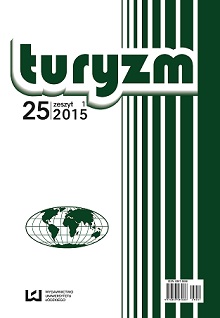Analysis of visitor attendance at Polish tourism attractions
DOI:
https://doi.org/10.2478/tour-2014-0019Keywords:
tourism attractions, attendanceAbstract
Tourism attractions are an important segment of the tourism market; they play an immense role in shaping the geography of the tourism movement. In spite of that studies devoted to tourism attractions are undertaken relatively rarely. In the present article, the author presents the results of research devoted to attendance at various types of tourism attraction in Poland, along with an attempt to identify the factors determining their popularity which is measured by the number of visitors. Among others, the author distinguishes the so-called flagship attractions which are of importance for the identity and general image of individual regions.
Downloads
References
COHEN E., 1972, Towards a Sociology of International Tourism, Social Research, 39, pp. 164-182.
Google Scholar
DAVIDSON R., 1996, Turystyka, PAPT, Warszawa.
Google Scholar
GOODALL B., 1990, The Dynamics of Tourism Place Marketing, [in:] G. Ashworth i B. Goodall (eds.), Marketing Tourism Places, Routledge, London.
Google Scholar
JENKINS O., 2003, Photography and travel brochures: The circle of representation, Tourism Geographies 5(3), pp. 305-328.
Google Scholar
KACZMAREK J., STASIAK A., WŁODARCZYK B., 2005, Produkt turystyczny, PWE, Warszawa.
Google Scholar
KRUCZEK Z., 2011, Atrakcje turystyczne. Fenomen. Typologia. Metody badań, Proksenia, Kraków.
Google Scholar
Kultura w 2012, 2013, Rocznik GUS, Warszawa.
Google Scholar
LEIPER N., 1990, Tourism Attraction Systems, Annals of Tourism Research, 17, pp. 367-384.
Google Scholar
LEASK A., FYALL A., 2006, Researching the Management of Visitor Attractions: International Comparative Studies, Tourism Recreation Research, 31, 2, pp. 23-32.
Google Scholar
LEW A., 1974, A Framework of Tourism Attraction Research, [in:] J.R. Brent Ritchie, Ch.R. Goeldner (eds.), Travel, Tourism and Hospitality Research. A handbook for Managers and Researches, John Wiley & Sons, New York.
Google Scholar
LUNDBERG D., 1985, The Tourism Business, Van Nostrand Reinhold, New York.
Google Scholar
MCCANNELL D., 2002, Turysta. Nowa teoria klasy próżniaczej, Wyd. Literackie Muza S.A., Warszawa.
Google Scholar
PEARCE P.L., 1998, Marketing and management trends in tourism attractions, Asia Pacific – Jurnal of Tourism Research, 3, pp. 1-8.
Google Scholar
PLAZA B., 2008, On some challenges and conditions for the Guggenheim Museum Bilbao to be an effective economic re-activator, International Journal of Urban and Regional Research, 32(2), pp. 506-517.
Google Scholar
RICHARDS G., 2002, Tourism Attractions System; exploring cultural behavior, Annales of Tourism Research, 29(4), pp. 1048-1064.
Google Scholar
SWARBROOKE J., 1995, The development and management of visitors attractions, Butterworth – Heinemann, Oxford.
Google Scholar
URRY J., 2007, Spojrzenie turysty, transl. A. Sułżycka, PWN, Warszawa.
Google Scholar
YALE P., 1990, From tourism attractions to Heritage Tourism, ELM Publications, Huntington.
Google Scholar
WEAVER D.B., LAWTON L.J., 2007, Just because it’s gone doesn’t mean it isn’t there anymore: Planning for attraction residuality, Tourism Management, 28, pp. 108-117.
Google Scholar
Downloads
Published
How to Cite
Issue
Section
License

This work is licensed under a Creative Commons Attribution-NonCommercial-NoDerivatives 4.0 International License.










